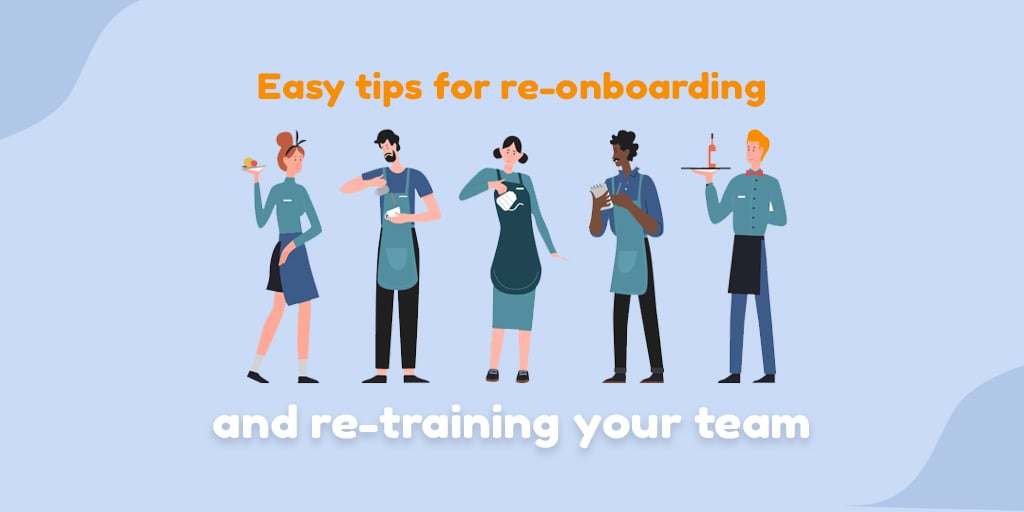The most important resource to any company isn’t the software you use or the equipment you own; it’s your workforce. Your employees are the single most impactful resource at your company’s disposal, but they’re also one of the most difficult resources to manage.
Employee turnover is a serious threat to any organization. According to research, 40% of workers are currently considering quitting their jobs within the next year. But the cost of employee turnover is much more than just monetary. It can also hinder your productivity, lower morale, and hurt your brand reputation. Here’s what you need to know about employee turnover costs.
What is employee turnover?
Employee turnover is the total number of workers who leave a business over a set period of time. This turnover rate includes all employees who leave, whether voluntarily or involuntarily (through layoffs, firings, etc.).
To calculate your business’s turnover rate, simply divide the numbers of employees who left your company by the total number of employees at the beginning of the set time period.
For example, if you had 100 employees at the beginning of the month and 7 leave, your employee turnover rate would be 0.07 or 7% for the month. Naturally, the lower the number, the better.
What is the average employee turnover cost?
According to Gallup surveys, the average cost of an individual employee turnover is between one-half to two times an employee’s annual salary for each employee you lose. For many businesses, employee turnover costs can easily reach into the hundreds of thousands of dollars per year — if not more!
If you consider the average employee salary is around $50,000, that means it’ll cost your business anywhere from $25,000 to $100,000 every time an employee leaves! If even only five employees quit in a given year, it can cost your company six figures, and that’s being conservative.
The real cost of employee turnover
The cost of turnover can be a serious drain on your company’s bottom line. But unfortunately, the monetary expense isn’t the only cost your business will have to pay. It might sound ridiculous that a simple turnover can cost you over six figures, but there are dozens of expenses that go into replacing employees, many of which can’t be measured in cash value.
These are just a few of the expenses that go into the total cost of turnover for your company:
Recruitment costs – The cost of finding and recruiting a new employee. This includes the advertising, job board subscriptions, screening, interviewing, and hiring processes.
Onboarding costs – The employee onboarding process typically takes a few days or even weeks to get a new hire up to speed with your company. All that time processing paperwork and training costs your company money.
Training cost – Training isn’t complete after the onboarding. New hires typically get on-the-job training during the early period of their employment. When your other employees take time to answer questions and train new hires, it costs your business in labor hours.
Lost productivity – It takes time for new employees to get up to speed with your business processes and their role. They’re usually less productive than experienced team members, which hurts your business’s overall productivity, not to mention the time other employees spend teaching new hires and away from their regular duties.
Lost engagement – It’s disheartening to see your team members come and go so quickly. High turnover rates can reduce team morale and hurt your existing team’s engagement with their jobs and the company as a whole.
Customer service – New employees take longer to perform their jobs and aren’t as quick at overcoming problems or understanding company processes. This can cause customers to become frustrated with their experience working with your company if they’re always talking to new employees.
Missed deadlines – The loss of productivity from new hires can cause your company to miss important deadlines, causing your company to lose money and perhaps even clients.
Lost institutional knowledge – Swapping out a long–time, experienced employee for a new hire means your company loses some of its skill and knowledge. The longer employees stick around, the better they understand your industry.
Cultural impact – When your employees see people leaving regularly, they start to wonder why and may begin to question why they still work there, hurting the workplace culture as a whole.
Brand damage – Poor customer service and missed deadlines will hurt your brand reputation with customers. Perhaps even worse, a negative brand reputation will also make it more difficult to find new employees to fill vacancies. Nobody will want to work for your company!
More turnover – By negatively impacting the culture and adding frustrations for your current employees, a high turnover rate can actually lead to more turnover, costing your business even more in the long run.
Now that you know everything affected by employee turnover, it’s easy to see how a single employee leaving can cost up to two times their annual salary!
How to calculate the cost of turnover
The multitude of elements that go into replacing an employee is what makes it so difficult to accurately calculate employee turnover costs. Many businesses don’t have systems in place to track expenses like total onboarding and training costs, loss of productivity, customer dissatisfaction, or exact labor costs in departments like HR, operations, and finance — but that doesn’t mean it’s impossible to get close.
If you want to calculate employee turnover costs, you’ll first need to collect some extensive data:
- Daily rate of departed employee’s salary
- Number of days the position will remain open
- Daily rate of the manager in charge of recruiting and screening new hires
- Advertising costs for the job posting
- Hours spent screening resumes
- Hours spent in interviews, both over the phone/internet and in person
- Cost of background checks
- Daily rate for hiring manager and trainer(s)
- Total days spent training the new employee
- Number of working days in the new hire’s first three months (your standard onboarding time)
Once you have the data, put it all together and calculate the cost of turnover per employee. You’ll need to calculate the cost of covering the vacant position, which is typically the departed employee’s daily rate multiplied by the number of days the position remains open. Then add it to the hourly rate of all the hiring managers, recruiters, HR team members, and trainers involved in the hiring process, multiplied by the number of hours they worked on the project. This will give you the cost of departure for a single employee.
Now, you can take the individual turnover cost and use it to determine the total employee turnover costs for a set period of time. First, calculate your turnover rate by dividing the total number of employees who left by the total number of employees for the given period. Then, multiply your total team size, turnover rate, and the cost of departure per employee.
For example, if you have a team of 100 people, a turnover rate of 7% annually, and a cost of departure of $20,000, your total annual turnover costs would look like this:
100 x $20,000 x 0.07 = $140,000 per year
That should give you a rough estimate of the total cost for the turnover of one employee. Of course, that still doesn’t take into account the loss in productivity, customer service, and employee morale — which are difficult to put into a dollar amount, anyway.
No matter how you spin it, employee turnover is a cost that no business can afford.
Factors that cause employee turnover
Naturally, with the exorbitant cost of employee turnover, it makes sense that you’d want to know how to avoid workers leaving for greener pastures. And surprisingly, it’s not always about pay. According to HR experts, these are some of the main causes of employee turnover:
Company culture
Nobody likes to work in a toxic work culture. It doesn’t take long for 40 hours per week in a negative culture to wear on you and cause you to look for something better. If employees don’t enjoy spending time at work, they’re not going to be as loyal to your company, their responsibilities, or the team as a whole.
According to polls, a toxic workplace is 10.4 times more likely to cause an employee to leave than anything pay-related. Your employees spend a lot of time at work. Do your best to make sure they enjoy it — or at least don’t hate it.
Leadership
Workers interact with their supervisors and managers every day. It makes a big difference whether a company’s leadership is polite and understanding with their employees or if they constantly bark orders. Bad leadership is a sure-fire way to encourage workers to leave a company.
According to Gallup, 52% of employees who voluntarily leave a company do so because of a manager. Whether it’s a bad manager, or just a simple lack of effort, encouraging your leadership to work with employees and take the time to build positive relationships can help you avoid the expensive cost of employee turnover.
Lack of opportunity
People always want to know they’re working toward something. Whether it’s that next big promotion or just picking up a few skills, available opportunities in the workplace is a major driver for employee retention. In fact, 63% of employees who voluntarily quit their jobs in 2021 cited lack of opportunities for advancement as one of the reasons for quitting.
Many business owners and managers have trouble maintaining opportunities for advancements for all their employees. After all, there are only so many needed positions! However, remember that upward mobility isn’t the only type of mobility. Continuing education and employee development opportunities are great ways to help your employees feel like they’re advancing in their careers without actually needing a fancy new title or corner office.
Communication
There’s nothing more frustrating than feeling like you’re stuck in a one-way conversation. Unfortunately, this is the reality for many employees around the world. They provide feedback to their managers about how to improve the business or operations, and all their amazing recommendations fall on deaf ears. This recurring frustration has a direct impact on employee turnover rates.
According to studies, businesses with effective communication channels are 50% more likely to have low employee turnover rates. With just a little bit of back-and-forth, you can avoid the high cost of employee turnover.
Lack of employee recognition
Not that you need to start handing out gold stars, but it’s always nice to feel appreciated for the work you do. Your employees work hard, and they want to feel recognized for it. If they don’t, they’re more likely to start looking for other opportunities for employment.
Around two-thirds of employees say they would quit their jobs if they don’t feel appreciated. This number jumps to 76% for younger generations like millennials and gen Zers. Recognizing your employees’ good work makes them feel more connected to the business, encouraging them to stick around for the long term.
Lack of flexibility
Ten years ago, work flexibility wasn’t something that was even on hiring managers’ radars. But ever since the COVID-19 pandemic brought about a boom in remote work, the flexibility to work when you want, where you want has been of the utmost importance for employees. In fact, 45% of people who quit their jobs in 2021 cited the lack of flexibility as a reason they left.
The days of the rigid 9-5 workday are quickly disappearing. Modern employees want the ability to create their own work/life balances, and employers who don’t allow that kind of flexibility will pay the cost in high turnover rates.
Don’t let employee turnover costs hinder your business
The cost of employee turnover isn’t something your business can afford. It’s much more than just the monetary value lost searching for and training new hires. It can also hurt your overall productivity, team morale, brand reputation, and much, much more.
The best way to reduce employee turnover costs is to pay attention to your team’s needs and desires. They’re not just a means to an end; they’re people and want to be treated as such. Consider your onboarding processes, ensure effective communication with your team, provide ample opportunities for advancement, and allow enough flexibility for your team to create the balance they need. In the end, the cost of creating a positive workplace for your employees immensely outweighs the cost of recurring employee turnover.
If you’re looking for more HR resources to help create efficient hiring and onboarding processes, check out the Workstream blog. You’ll find plenty of helpful articles to get your processes on track to build the perfect team for your business.





